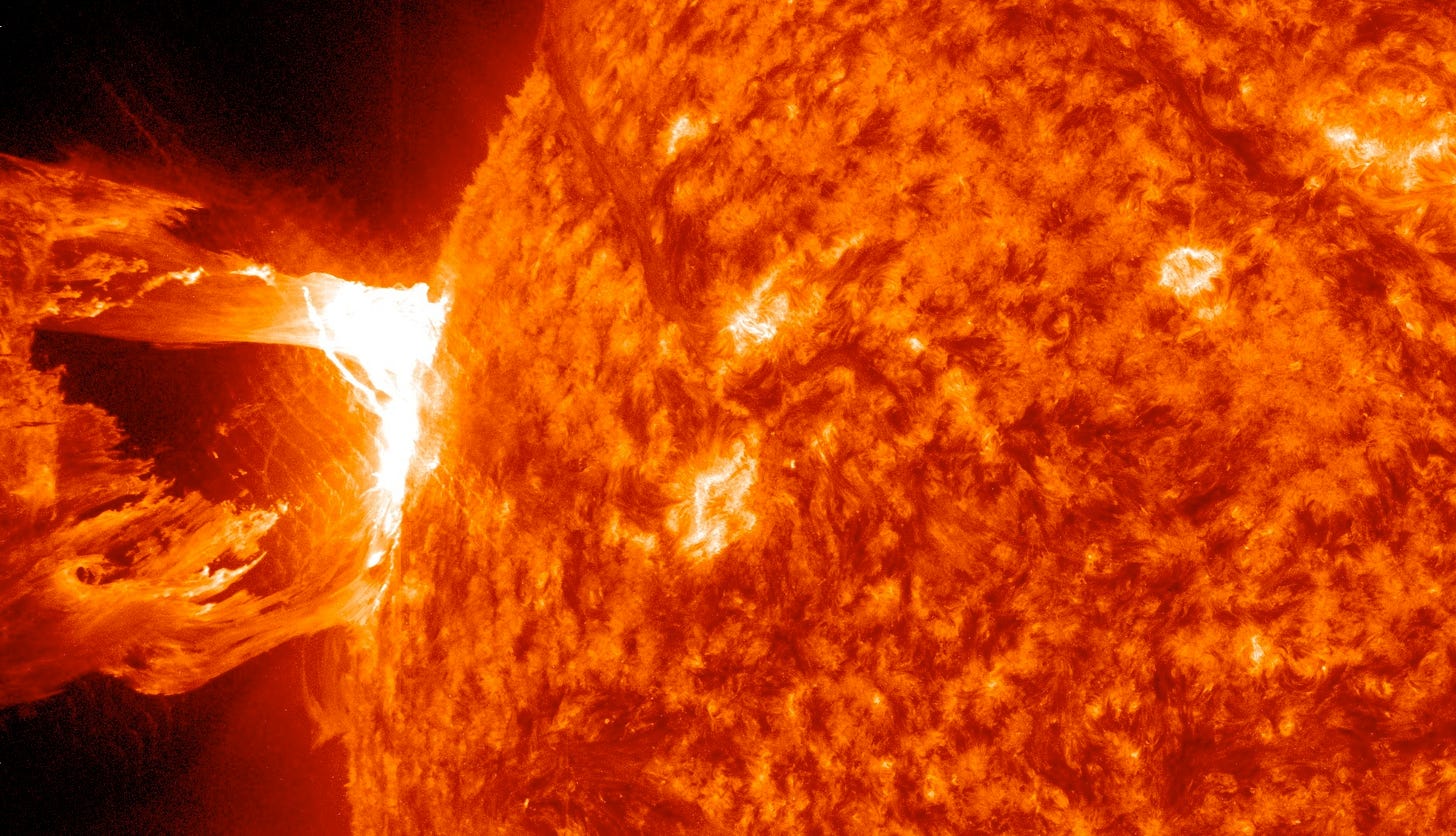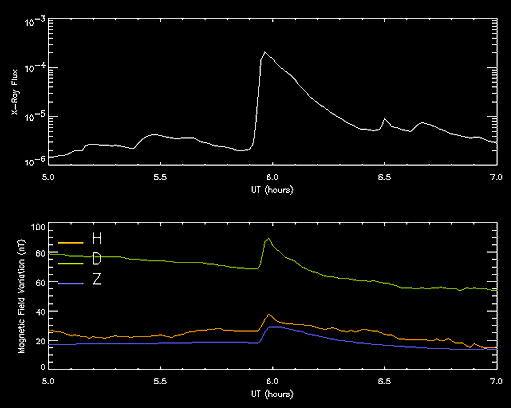Prologue
On the first of September 1859 two english astronomers, Richard Carrington and Richard Hodgson independently observed a solar flare from the suns surface. What they were seeing was gigantic eruption of the sun’s coronal mass into space and this time the earth was directly in it’s path. With that coronal mass ejection (CME) also came a flood of x-rays that plowed into the earths upper atmosphere (called the ionosphere) causing a magnetic storm so strong that the Aurora was seen in Australia as far north as Queensland. Lasting a week, at their peak the magnetic field generated were so intense that they created currents in telegraph lines strong enough to shock operators and cause equipment failures.1
We don’t empirically know how strong the Carrington Event was, as measuring field strength only started in the 1920s, but it is the only recorded event which appears in the top five events for sudden ionospheric disturbance, solar wind, geomagnetic storm and aurora. Adding to it’s magnitude there were actually two separate auroral events one on the 28 August and an even more widespread display on 2 September. Big as it was there’s evidence that the Carrington event was not the most severe CME ever to hit the earth with Carbon isotopes indicating an event in 775 AD as being 10 times it’s size. Our sun it seems is prone to recurring and violent temper tantrums of god like proportions.
Solar weather and us
In 1859 the extent of damage to society extended to the loss of telegraph services for a couple of days and some shocked telegraph operators, and the event was considered nothing more than an interesting scientific curiosity. Fast forward then to March 1989 and the upper atmosphere above Quebec Canada. The solar storm struck at 3 a.m. on 13 March collapsing the Hydro-Quebec power grid in less than two minutes and very nearly taking out the entire North Eastern American power grid through as series of cascading power failures. As measured the storm reached −589 nano Tesla (nT) on the Dst scale, the strongest since standard storm strength indices were used in 1932. Bad though the Quebec event was in comparison the Carrington event is estimated to be three times worse at -1,600 to -1,760 nT. Analysis of historical records of auroras indicate that a Carrington sized even has a median return period of 150 years while one the size of Quebec has a median return period of 50 years.2 As to the comparative damage that a Carrington storm could produce well, the Quebec storm and subsequent 9 hour outage cause an estimated 13 $ Billion dollars worth of economic losses including damaging the grid. A 2013 analysis by Lloyds of the effect a Carrington event would have put the potential losses (for the US alone) from such an event at $670 billion to $2.9 trillion in 2020 dollars.
Grid 2.0 as a common cause failure
All this is bad, if we get hit by an event, and sure there’ll be an economic hit but why should we worry overmuch? After all if a few transformers blow up due to induced heating well they can be replaced right? Uh, not so fast. You see one of the tenets of the Energy transition is that we can and should transition everything that we can onto the grid. So rather than heating our homes with gas we use heat pumps. Rather than powering our cars with fossil fuels we use batteries which are charged from the grid or hydrogen generated electrolytically. To work, the energy transition requires that we put all our technological eggs in one basket. So let’s reimagine the Quebec event, with the power grid down in winter with no way for people to charge their cars or heat their houses.34 Then let’s think about the effect of a protracted loss of power over days or weeks due to a Carrington level event. Fundamentally the highly connected Grid 2.0 then becomes a common cause failure mode for our technological society.5 How do you ferry replacement transformers out to the field if the truck can’t get a charge or there’s no hydrogen in the electrolyser? That is of course presuming that there are replacement transformers available. And this is the point, if Grid 2.0 drops the machine we call society stops.6
So it turns out that the consequences of the new grid failing during a Carrington event are much worse than even the original authors of the 2013 report anticipated. That’s bad, but surely that’s it? Well, no that’s not all I’m afraid. You see over the last 50 years or so the High Voltage grid that ferries power around has grown dramatically, in Australia we have been busy connecting the various states individual grids together so that we could form what we call the National Energy Market (NEM) down the Eastern and Southern seaboards. Economically this makes sense because when one state has lower needs it’s power can be provided to another which does. Indeed this interconnection is vital for the success of a renewables driven energy system as it allows us to take wind power in Queensland and offset a lull in the winds over South Australia. We’ve also progressively increased the high voltage lines carrying capacity by increasing the voltage and increasing line conductivity to reduce line losses. Likewise lower resistance transformers are now used than say during the 50s and 60s. All eminently sensible. Unfortunately what this does in combination is effectively build a larger and more sensitive antenna for geomagnetic induced currents that channels them into the equipment that is most vulnerable. What effect this would have on renewable generators would depend on whether their site protection gear would function appropriately and disconnect from the grid, something of an unknown.
Another factor to consider, because wind and solar farms are dispersed we need to connect them back to the grid using, you guessed it, high voltage transmission lines. So again the renewables driven energy transition requires an energy supply system that is far more widely dispersed and therefore has even more high voltage cabling and transformers that can act as antennas pick up the geomagnetic induced currents.7 This could result in a lot of cooked transformers with no easy or quick way to repair them as well as damage to those solar and wind farm generators that were unable to disconnect from the grid.
Finally the non-dispatchable nature of wind and solar would in the event of a CME hamper the ability of the network manager to minimise CME effects by spreading generation evenly. One thing we do know from outages like the South Australia blackout is that networks can exhibit a whole range of unexpected emergent failure modes.
Well this is a fine pickle you’ve got us into!
To summarise where we are. Renewables and grid economics are driving us to build a grid that is far better as acting as an antenna for geomagnetic induced currents than was the case. This trend will continue as we have only just started to build the fleet of renewable generators and connect these resources to where they’re needed. This increases the likelihood of severe effects in the event of a Carrington level event. In concert we intend to put everything onto this grid so the grid must work for society to work. This increases the subsequent severity of loss events from extremely severe but recoverable to potentially catastrophic. We know that Carrington events occur regularly and in fact the last one occurred in 2013, luckily missing the earth, so the probability is 100% that such a scenario will occur within the lifetime of Grid 2.0.
Doing something about it
There’s no magic wand that we can wave here, nor can we wish away the risk. What’s required is, in simple terms, the hardening of the grid to reflect it’s criticality and the risk associated with that criticality. For example after the Quebec storm Ontario Hydro invested $1.2 billion dollars into hardening their systems to protect the grid infrastructure.8 We should, but are not as far as I can see, do the same thing in Australia to protect our grid against a Carrington event at the least and ideally against the worst that we know has occurred.9 We should also ensure that the protection systems for the generation and storage that connect to the grid are sufficient to protect these assets for the peculiarities of geo-magnetic induced currents, it is after all not much good if your grid is fine but you can’t actually put any power into it. As an added benefit doing so would also protect the grid from the effect of man-made threats in the form of Electromagnetic Pulse (EMP) weapons.10
At the moment I’d describe our grid as robust but fragile, in that for the specified set of network fault conditions it will be able to adjust and continue to provide a service. If a Carrington event turns up that the system is not designed to cope with it will unfortunately fail catastrophically. The grid’s fragility in the face of the unexpected/unspecified means that it is not resilient, e.g. it doesn’t have the ability to absorb a significant degree of unspecified damage or disruption and then recover from it. Part of that resilience can be built in via hardening and part of it has to be dynamic via the network system manager having the tools to reconfigure and salvage/restore on the fly.
Closing thought
Maybe if we’re going to put all our eggs in one basket we ought to expect that basket to be pretty damn resilient. We really do not want to end up as the modern equivalent of one the ancient water empires of the Middle East.11
Notes
In one instance the operators disconnected the power and ran their telegraph off the storm generated currents.
This does not mean they trundle along every 150 years rather that in any year there’s a 1 in 150 chance of such an event. So, how lucky do you feel?
In fact we don’t have to imagine this as the Germans will be living this scenario this winter.
In Australia an explosion at a fuel refinery at Longford in Victoria left that state without gas supples for 20 days. Electricity however was still available.
Technical speak for a common factor that causes the failure of systems or components that we might (naively) think were independent. Yes I think about this for a living.
The subsequent criticality creep of the power grid is something that the authors of the 2013 analysis obviously did not consider. Criticality creep is a recurring theme when we start to integrate disparate systems together into what engineers call a system of systems.
The various state declared renewable energy zones are great for ensuring this.
For example by fitting blocking capacitors.
In the US for example geo-magnetic storm risk maps are generated to assist utilities in assessing risk and planning mitigations. Maybe the CSIRO could do something similar for Australia.
Created by detonating a nuclear weapon in the ionosphere.
They relied on a sophisticated water irrigation scheme which worked fine until the channels silted up. Then their wonderful civilisations just, stopped.



I think brittle is a good word here. Strong until it isn't, and then fails catastrophically.
Like to tightly optimized just-in-tume supply chains as well.